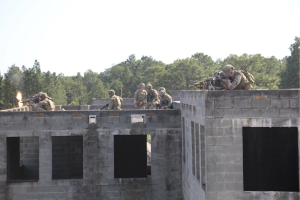The U.S. Army Special Operations Command (USASOC) for the first time this century reported the initiation of drills simulating operations on Taiwan. The drills on April 27, which were part of annual capabilities exercises at Fort Bragg, North Carolina, were reported to involve practicing the insertion of personnel onto Taiwan. Troops fired recoilless rifles, breached tunnels, operated Switchblade drones, and, according to a report by Military.com, operated “other tools reflecting a seismic shift for the command as it prepares for potential conflict against major military rivals.”
Commander of USASOC Lieutenant General Jonathan Braga stated preceding the exercise that it reflected China’s emergence as “our true pacing challenge out there,” which he emphasized was in accordance with the latest U.S. National Defense Strategy.
Military exercises simulating fighting on Taiwanese soil, and the focus on special operations forces in particular, are especially significant when considering the recent discourse surrounding the United States’ position in the Taiwan Strait. In particular, the possibility has been raised that U.S. special forces could play a key role in contributing to a fight against the People’s Liberation Army, especially for training and logistics – a similar role to the one they are currently playing in Ukraine against Russian forces.
In late March, Congressman Mike Waltz, a former U.S. Army Special Forces service member and now chairman of the House Armed Services Committee on Readiness, spoke about U.S. moves to deeply reform Taiwan’s armed forces – and the need, in his words, to facilitate a “Ukraine-style resistance.”
“They know that their training needs to be more realistic and probably more wholesome… They’re sitting around a lot not really having realistic difficult exercises and training when they need it,” Waltz said in remarks at the Center for Strategic and International Studies. “…We particularly in the special operations community are working with them to move more towards a partisan resistance model,” he added.
It was outlined at the time that this would include not only greater deployments of U.S. personnel to Taiwan, which have recently continued to expand significantly, but also growing deployments of Taiwanese personnel to training ranges in the United States.
At the same CSIS event in late March, former U.S. Army Special Forces serviceman and ranking member of the House Foreign Affairs Subcommittee on Accountability Congressman Jason Crow, who also served on the House Armed Services Committee, outlined the key roles U.S. special forces would play in a Taiwan contingency particularly for facilitating arms transfers to Taiwan during a potential war:
We don’t have a land border with Taiwan. [We face] the tyranny of distance and the very big challenges of resupply over an open ocean. Covert Special Operations have a very important part to play in that in addition to the pre-positioning and the hardening [of arsenals on Taiwan] that’s going to be essential. But pre-positioning and hardening alone is not going to do it. There’s going to have to be some supply chain that will largely rely on our unconventional forces to do so.
Crow contrasted this specifically to the long land borders that NATO shares with Ukraine, where, among a wide range of other roles, U.S. and other Western special forces have been key to facilitating the flow of arms from Europe to the frontlines.
One of the most significant insights into the operations of Western special forces in Ukraine was provided by a New York Times report in July 2022, which observed that the United States had set up within Ukraine’s borders “a stealthy network of commandos and spies rushing to provide weapons, intelligence and training… C.I.A. personnel have continued to operate in the country secretly, mostly in the capital, Kyiv, directing much of the massive amounts of intelligence the United States is sharing with Ukrainian forces.”
The “signs of their stealthy logistics, training and intelligence support are tangible on the battlefield,” the report observed. “Commandos from other NATO countries, including Britain, France, Canada and Lithuania, also have been working inside Ukraine… training and advising Ukrainian troops and providing an on-the-ground conduit for weapons and other aid,” it noted, stressing the sheer “scale of the secretive effort to assist Ukraine that is underway.”
As a result, Ukrainian forces have benefited significantly from tremendous quantities of intelligence, including battlefield mapping applications to target and attack Russian units and intelligence imagery from hundreds of Western military satellites. More information on the operations of Western personnel, including frontline combat operations by elite British Marine units from the war’s initial weeks, have since emerged, setting a strong precedent for similar U.S. and Western special operations on Taiwan.
Congressman Crow highlighted that this level of collaboration between U.S. special forces and local forces in Ukraine did not occur overnight. “Just about the training, you look at Ukraine. People are amazed with our ability to have interoperability with Ukraine. That’s because it started in 2014. We have been doing it for almost a decade prior.” Commentators have made frequent references to Western efforts in Ukraine having succeeded due to a full eight years of preparation, including overseeing deep reforms of the Ukrainian military. These analyses provide some indication of the likely intention behind the escalation of Western deployments and exercises on Taiwan.
The announcement of special forces operations on the territory, which are likely to similarly focus on serving as force multipliers for local units through logistics and intelligence support, is potentially one of several steps in this direction to maximize the United States’ ability to combat mainland Chinese forces through Taiwan in the event of a war as was done in Ukraine.
Although leading Western analysts have consistently highlighted the Ukrainian population’s “iron resolve to fight to the death” this has often been sharply contrasted with Taiwan. U.S. special forces deployments represent a critical part of efforts to cultivate a Taiwanese capacity to wage a Ukraine-style war effort and adopt a “partisan resistance model.” Even partial success in achieving this would be a highly favorable development for Western interests in the region.

































